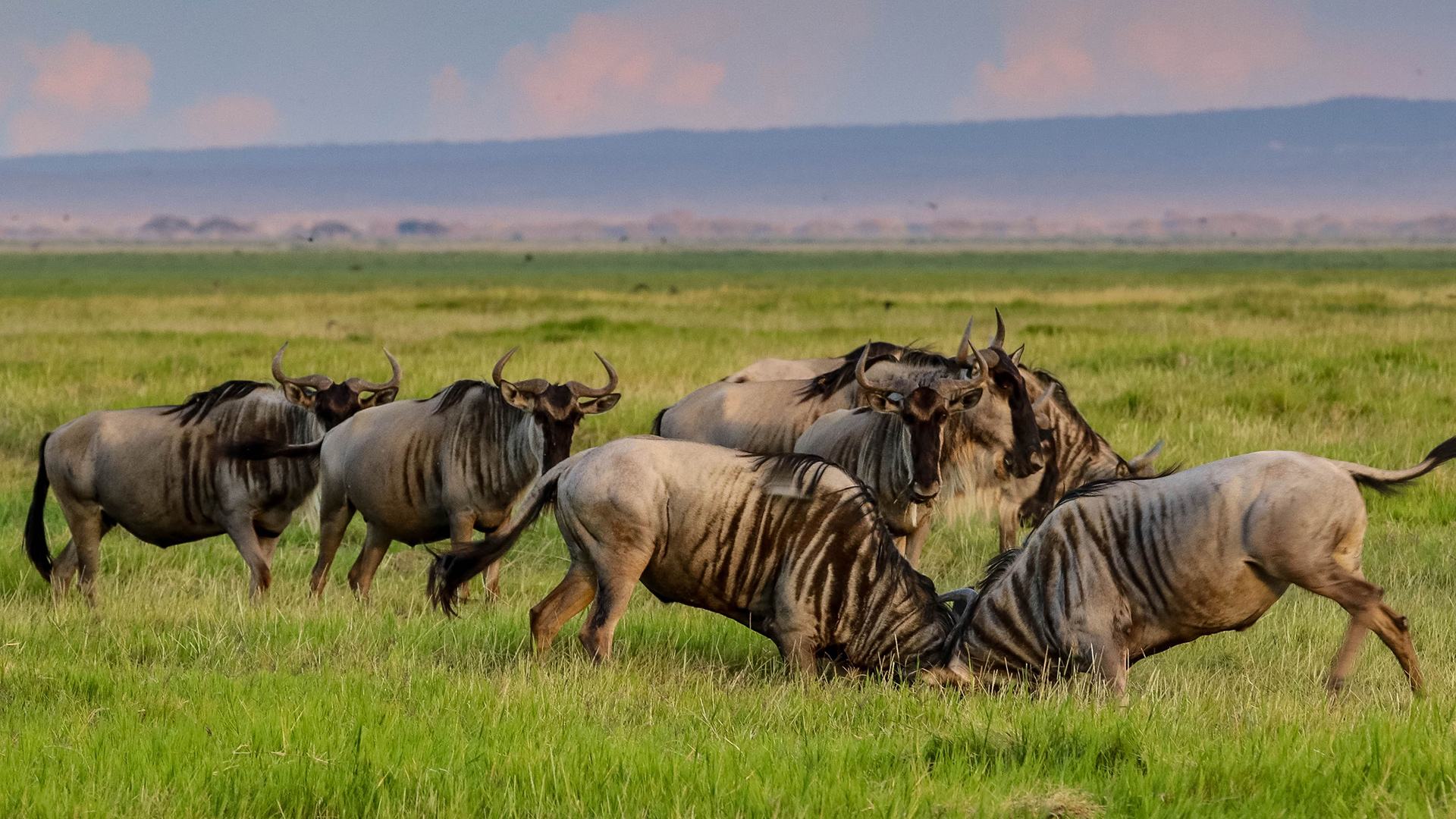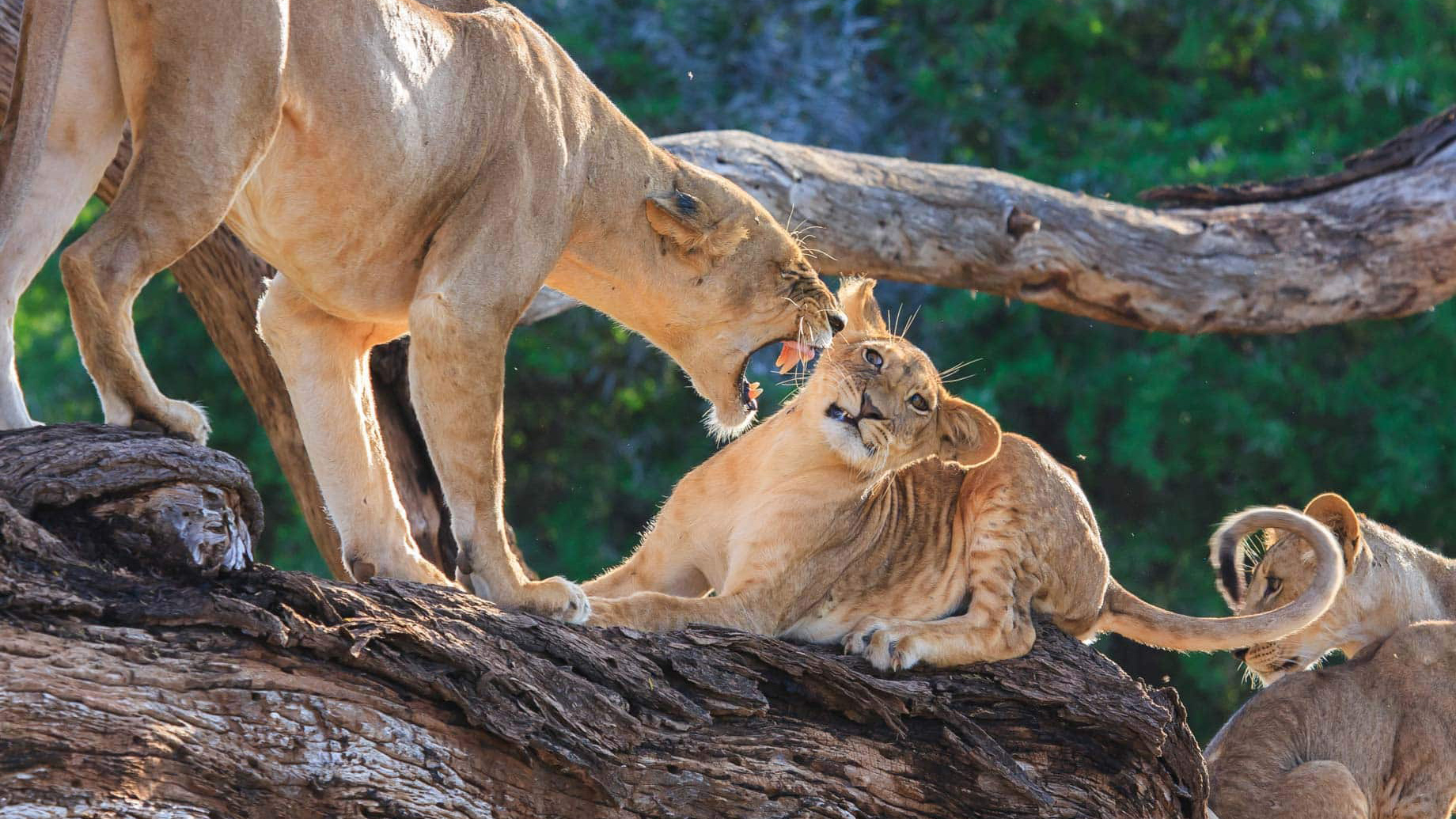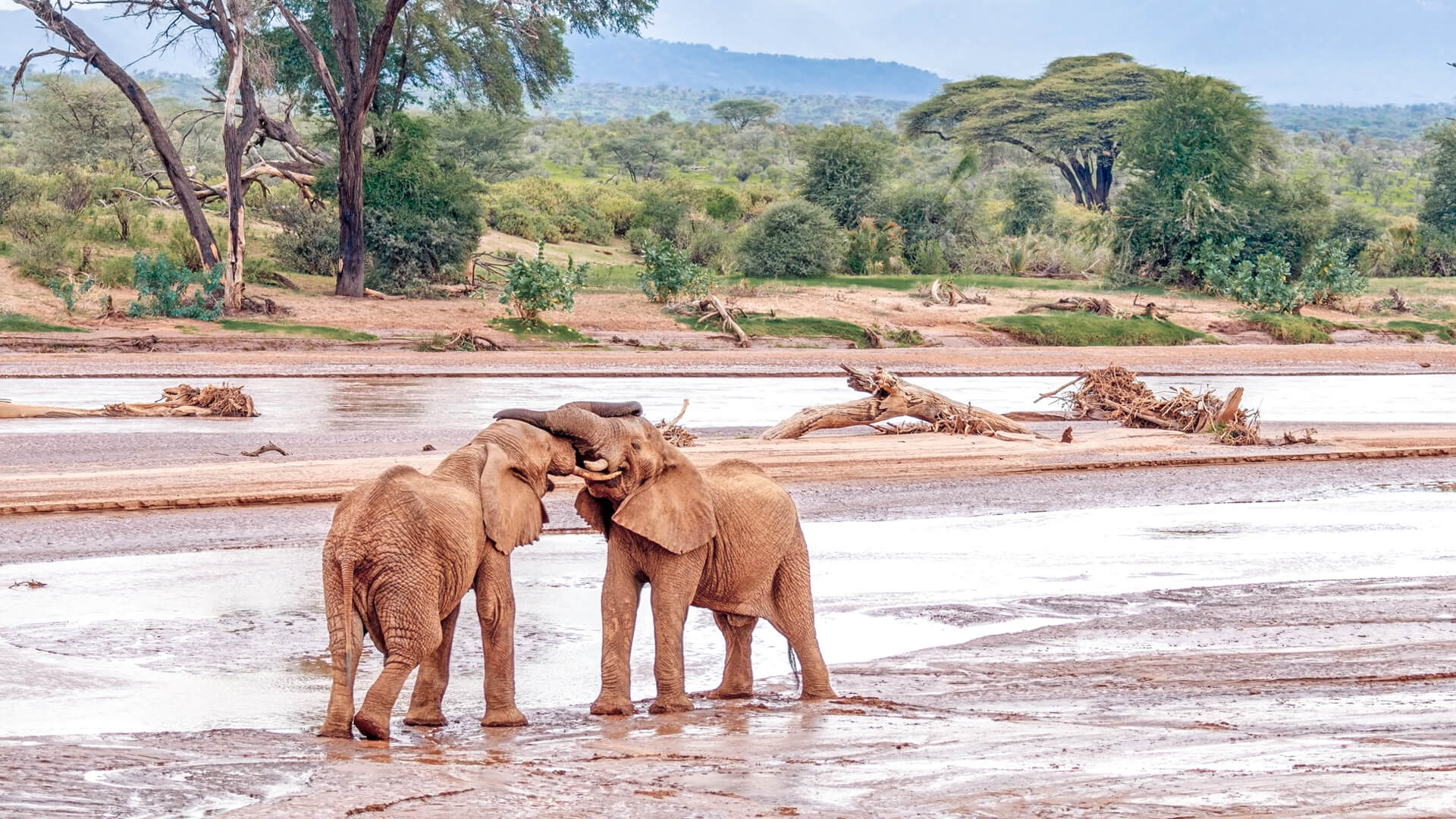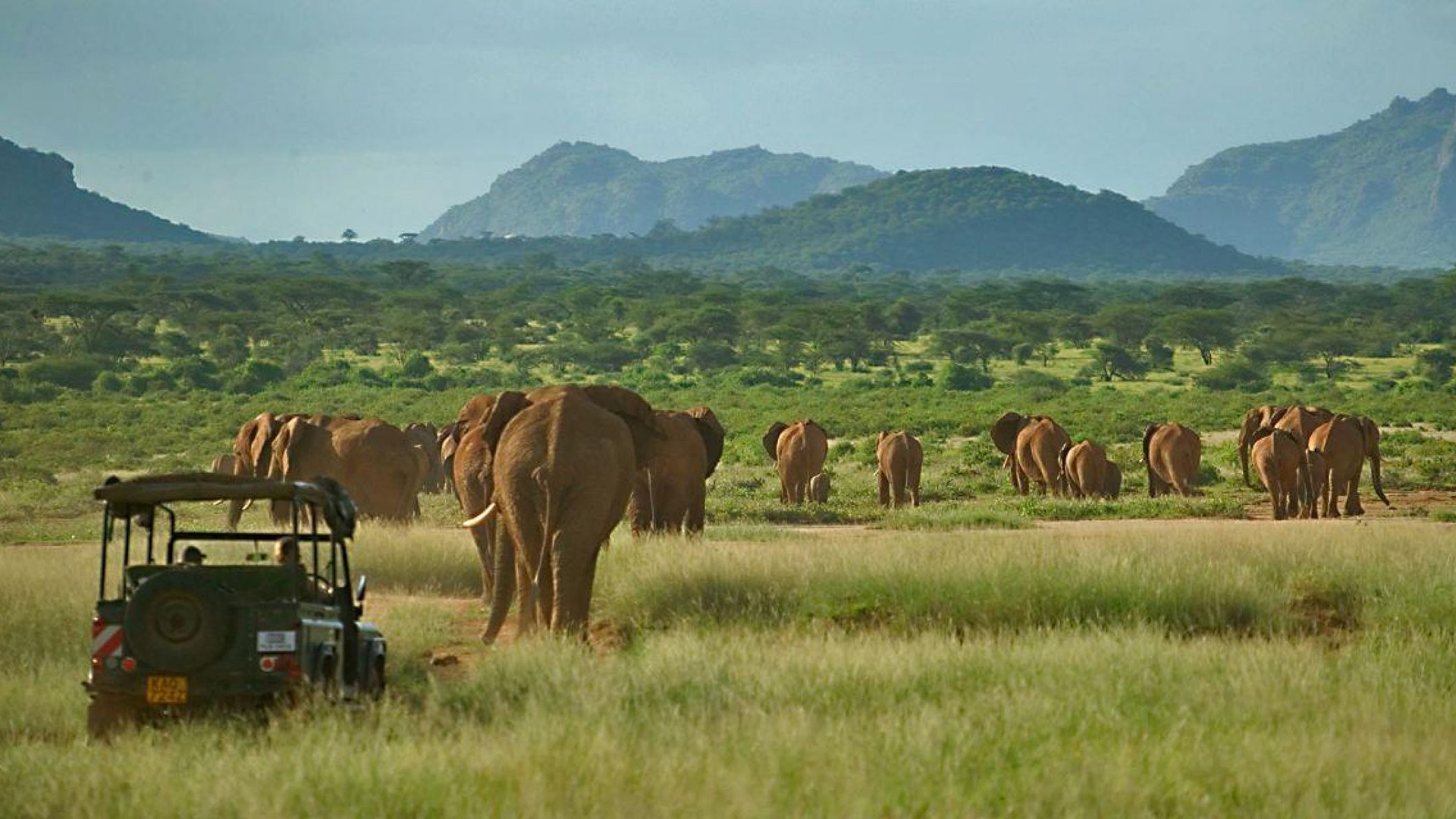




Samburu – Aberdares – Bogoria - Lake Nakuru – Naivasha - Maasai Mara
-
Duration
9 Nights 10 Days -
Budget
From USD 1745 Per Person Sharing -
Destination
Africa -
Language
English -
Type
Explore
Day 1: Nairobi
Upon arrival at the airport you will be warmly met by our Dawin Tours & Travel representative who will welcome you to our beautiful country Kenya. He will brief you on your safari and later transfer you to your hotel for some leisure time and later dinner and overnight at the Ole Sereni Hotel DBB
Day 2: Samburu National Reserve
Enjoy breakfast, then at 0800hrs your driver guide will meet you and help you with the check out procedures. You will then depart for the Samburu National Reserve which is located further north of the equator. Samburu National Reserve is home to Kenya’s special five; Somali ostrich, grevys zebra, gerenuk, reticulated giraffe and the beisa Oryx. These animal species are rarely found in any other parts of Kenya. Arrive at your lodge at approximately 1230hrs, check in and later enjoy your lunch. In the afternoon you will have some time to relax before heading out for an afternoon game drive at 1500hrs. Be on the lookout for the special five as well as the famous five. Later return for dinner and overnight at Samburu Simba lodge LDBB
Day 3: Samburu National Reserve
Samburu National Reserve is located in the arid region of Kenya and thus a lot of savannah plains and occasionally hills adorning the landscape. You will spend the whole day in the wild and hopefully locate the buffalo, leopard, elephant, lion and the special five. Your driver guide will pick a perfect location where you will enjoy your picnic lunch at 1300hrs before continuing with the game drives in the afternoon. Later in the evening at 1800hrs you will return to Samburu Simba lodge LDBB for dinner and overnight.
Day 4: Aberdares National Park
After breakfast depart at 0730hrs for the Aberdares national park located in the central region of Kenya. It is home to the rare bongo. Arrive at the Aberdares country club at 1300hrs for lunch. Enjoy lunch at this base hotel for the ark. You will leave your bags here and only take an overnight bag to the Ark. You will enjoy an en-route game drive in the hotels vehicle as other tour vehicles are not allowed. Arrive at the Ark. Check in and enjoy viewing the animals from the balcony as they come to take water in the nearby waterhole from approximately 1430hrs to 1800hrs. Enjoy dinner and overnight at The Ark LDBB
Day 5: Lake Bogoria National Reserve
You will check out of the Ark very early in the morning at 0630hrs. You will be transferred to the Aberdares Country club where you will enjoy your breakfast. Later at 0700hrs depart for Lake Bogoria. Arrive at your resort at approximately 1230hrs. Check in and then enjoy some leisure time before lunch which will be served at 1300hrs. This afternoon you will visit the Lake Bogoria National Reserve which is home to the endangered Greater Kudu. You will see Lake Bogoria well known for its hot springs. Return to your resort at 1800hrs. You will enjoy dinner and overnight at Lake Bogoria Spa Resort LDBB
Day 6: Lake Nakuru National park
Enjoy breakfast at your resort at 0800hrs then depart for Lake Nakuru national park. Check in and enjoy lunch at your lodge at 1300hrs. Later at 1400hrs, enjoy an afternoon game drive in this Ornithological paradise. Be on the lookout for both the black and white rhino. This park is home to millions of lesser and grater flamingos. At 1800hrs, head back for dinner and overnight at Lake Nakuru Lodge LDBB
Day 7: Lake Naivasha
Enjoy breakfast at the lodge then at 0830hrs depart for Naivasha with an en-route game drive at Lake Nakuru National Park. Arrive at your tented camp at approximately 1230hrs. Check in, then later enjoy some leisure time before lunch which will be served at 1300hrs. This afternoon you will be spent at leisure enjoying the camp’s facilities. Later at 1900hrs, enjoy diner and overnight at Crater Lake Tented Camp LDBB.
Day 8: Maasai Mara National Reserve
Enjoy breakfast at the camp and later at 0730hrs depart for the World renowned Maasai Mara National Reserve. It’s the home to the 7th wonder of the world. Here you may see all the big five and thousands of other animals grazing in this beautiful reserve. Arrive at your lodge at 1300 hrs, check in then enjoy lunch. At 1400hrs you will enjoy an afternoon game drive. Return at 1800hrs for dinner and overnight at Mara Simba Lodge LDBB
Day 9: Maasai Mara National Reserve
Enjoy a very early morning game drive from 0600hrs to 0900hrs. Be on the lookout for the elephant, rhino, buffalo, lion and leopard. You will also see lots of wildebeests, zebras, gazelles and other animals. Later return to your lodge at 0930hrs for breakfast. Spend the rest of the mid morning at leisure enjoying the lodges’ facilities. Enjoy lunch at the lodge at 1300hrs. Later at 1430 hrs head out for yet another exciting game drive. Return for dinner and overnight at Mara Simba Lodge LDBB
Day 10: Depart
After breakfast check out of the lodge at 0800hrs. You will enjoy an en-route game drive as the safari comes to an end but fortunately you have all the lovely moments captured on camera and will forever be great memories. Upon arrival in Nairobi where you will be transferred to the carnivore restaurant for lunch and later you will be taken to the Jomo Kenyatta international airport for your homebound flight.
|
Cost per adult sharing in a double room in US$ |
Peak |
SRS |
High |
SRS |
Low |
SRS |
|
4,700.00 |
1975.00 |
4,400.00 |
1845.00 |
4,200.00 |
1745.00 |
|
Extra Activities |
Cost per person |
|
Visit to a Maasai village |
US $40.00 |
|
Hot air Balloon |
US$ 550.00 |
|
Bush Breakfast |
US$ 60.00 |
|
Nairobi City Tour |
US$ 100.00 |
|
Visit to a Samburu village |
US $40.00 |
Cost includes:
- Airport transfers
- Domestic flights
- Accommodation on full board basis on safari and half board in Nairobi and in South Coast
- Park entry fees
- Comprehensive game drives in the parks and reserves
- Transport in a safari minivan with 6 guaranteed window seats
Cost Excludes:
- Tips and gratuities
- Personal effects and laundry
- Drinks
- Any other costs not expressly stated above
|
SEASON |
FROM |
TO |
|
Peak |
20th December 1st July |
31st March 31st October |
|
High |
1st June 1st November |
30th June 19th December |
|
Low |
1st April |
31st May |
ACCOMMODATION INFORMATION
Ole Sereni Hotel
There is something breathtaking about waking up to the sight of zebras, giraffes, ostriches and gazelles grazing right outside your window. This is the kind of treat you can only enjoy at Ole-Sereni the city hotel by the game park. The hotel has 134 Rooms and Suites, 4 Food and Beverage outlets and a decadent health club combined into three elements of luxuries comfort, the wild and the wind. Business amenities include a 24-hr business centre, technology support staff and audio- visual equipment, making the hotel perfect for events and conferences.
Samburu Simba Lodge
Samburu Simba lodge overlooks the Buffalo springs and the Uaso Nyiro River. From the rooms one has a fantastic view over the stunning plains, where elephants are grazing. Nearby rare game – reticulated giraffe, Grevy’s zebra, Beisa orynx and long-necked gerunuk can be seen. It has seven villas of ten rooms each – six on the ground floor and four on the first floor of which two rooms are interconnected.
The Ark
Set in the heart of the Aberdares National Park, The Ark overlooks a floodlit waterhole and salt lick, which attracts a host of awesome wildlife. Modeled after Noah's Ark, The Ark has four viewing decks with balconies and lounges to provide superb game viewing from the comfort of the lodge. All cabins have an en-suite shower and bathroom. Accommodation in The Ark is in the form of cabins that are self-contained with a shower and toilet.
Lake Bogoria Spa Resort
Lake Bogoria Spa Resort is the only spa resort in Kenya with a naturally heated Spa pool. The resort is known as the healing place because of the therapeutic values associated with the spa and the hot spring geysers. Lake Bogoria has been described in the past as the ‘the jewel of the Rift Valley and by the words of Bishop Hanington on the first sight ‘the most beautiful view in Africa’s set in the acacia surroundings of the floor of the Great Rift Valley. The resort has 6 executive suites, 37cottages, 30 junior suites, 22 standard rooms and 20 spacious tents.
Lake Nakuru Lodge
Situated in the south eastern ecological niche of the park is the Lake Nakuru Lodge, an oasis of comfort and excellent services with commanding views of the lesser Flamingo interspersed with the Greater Flamingo for which Lake Nakuru is justly famous. The lodge offers accommodation in 95, spacious deluxe rooms-which have a glass sliding door- all with en suite bathrooms with permanent showers, and also have great views of the park, garden or lake, and 2 suites with private veranda and a sitting room. There is also a special treat….the zebra room; which is the oldest at the lodge and is now 100 years old…it was the first building on the site. Guests will enjoy excellent cuisine at the Mutarakwa restaurant, serving buffet breakfast, lunch and dinner on live cooking counters. Mama Nikki bar comes alive at night where traditional dance performances are held.
Crater Lake Tented camp
The camp is built on the shores of green volcanic like in the bottom of an old volcanic crater. The crater is 87 hectares in extent and the lake takes up to 14 hectares of this area. The camp comprises of eight double rooms and two permanent family bandas, all which are en suite with hot and cold showers. Honey moon suite which has a large bush pole bed and double Jacuzzi. All rooms look out over the lake. There is a fully stocked bar, dining room, verandah and a conference room, and the camp is popularly known for its full meals and snacks.
Mara Simba Lodge
The Mara Simba lodge sits overlooking a dramatic bend on the bank of the Talek, a tributary of the Mara River, gently blending into the surrounding wilderness. Stretching almost a kilometer along the river the grounds on the bank remain in their virgin condition, while the landscaped gardens filled with indigenous trees at the back draw a great variety of birds and butterflies. The lodge was conceived with an emphasis on exclusivity and comfort. It was designed to complement its surroundings and is decorated in Maasai traditional style. Wide, well-lit pathways connect the Public areas and rooms. Mara Simba is an environment friendly lodge as it has installed a sewage treatment plant. The plant provides crystal clear water that is used for irrigation. It has 84 guest rooms, arranged in clusters of 6 in each natural wood and stone Banda comprise 60 twin rooms, 12 double, 4 double and single and 8 triple rooms. They all have en-suite showers. Each spacious room, which can easily accommodate an extra bed, opens onto its own private veranda with uninterrupted views across the river.
LOCATION INFORMATION
Nairobi
Nairobi is the capital and largest city of Kenya. The name "Nairobi" comes from the Maasai phrase Enkare Nairobi, which translates to "cold water". However, it is popularly known as the "Green City in the Sun" and is surrounded by several expanding villa suburbs. Founded by the British in 1899 as a simple rail depot on the railway linking Mombasa to Uganda, the town quickly grew to become the capital of British East Africa in 1907, and eventually the capital of the newly independent Kenyan republic in 1963.
Nairobi is the one of the few cities in the world with a national park within its boundaries, making it a prime tourist destination as well, with several other tourist attractions. The most famous is the Nairobi National Park. The national park is unique in being the only game-reserve of this nature to border a capital city, or any major city. The park contains many animals including lions, giraffes, and black rhinos. The park is home to over 400 species of birds. The Nairobi Safari Walk is a major attraction to the Nairobi National Park as it offers a rare on-foot experience of the animals. Nairobi is home to several museums, sites, and monuments. The Nairobi national Museum is the country's National Museum and largest in the city. It houses a large collection of artifacts portraying Kenya's rich heritage through history, nature, culture, and contemporary art. Other museums include the Nairobi Gallery, Nairobi Railway Museum and the Karen Blixen Museum. Uhuru Gardens, a national monument and the largest memorial park in Kenya, is also the place where the first Kenyan flag was raised at independence.
Nairobi's night life is very popular with tourists, both young and old. From a collection of gourmet restaurants offering local and international cuisine, Nairobi has something to offer to every age and pocket. Most common known food establishments include The Carnivore and The Tamarind Restaurants. For those more discerning travelers, one can choose from a wide array of local cuisine, Mediterranean, fast food, Ethiopian, and Arabian. The city's nightlife is mostly centered along friends and colleagues meeting after work. Other sites include Jomo Kenyatta’s Mausoleum, Kenya National Theater and the Kenya National Archives. Art galleries in Nairobi include the Rahimtulla Museum of Modern Art (Ramoma), the Mizizi Arts Centre, and the Nairobi National Museum.
Samburu National Reserve
The Samburu National Reserve is located on the banks of the Ewaso Ng’iro River. On the other side of the river is the Buffalo Springs National Reserve. The park is 165 km² in size and is situated 350 kilometers from Nairobi. In the middle of the reserve, the Ewaso Ng’iro flows through doum palm groves and thick riverine forests. It provides water, without which the game in this arid region could not survive. The Samburu National Reserve was one of the two areas in which conservationists George and Joy Adamson raised Elsa the Lioness made famous in the bestselling book and award winning movie Born Free. The Samburu National Reserve is also the home of Kamunyak, a lioness famous for adopting Oryx calves. There is a wide variety of animal and bird life seen at Samburu National Reserve. Several large game species common to Kenya's northern plains can be found in abundance here, including the following dry-country fauna: gerenuk, grevy’s Zebra, Oryx, reticulated giraffe, lion, cheetah, leopard elephant, buffalo and hippos.
Aberdares National Park
The park is located about 100 km north from Nairobi and stretches over a wide variety of terrains because it covers altitudes from about 7,000 feet to 14,000 feet above sea level. Established in May 1950, the Aberdares National Park covers an area of 766 square kilometers and forms part of the Aberdares Mountain Range. The park contains a wide range of landscapes - from the mountain peaks that rise to 14,000 feet above sea level, to their deep, v-shaped valleys intersected by streams, rivers, and waterfalls. Animals easily observed include the leopard, elephant, African hunting dog, forest hog, bushbuck, reedbuck, waterbuck, cape buffalo, suni, stripped jackal, eland, duickers, olive baboons, black and white Columbus monkeys, golden cat and the rare bongo. Animals like the eland and spotted and melanistic serval cats can be found higher up in the moorlands. The Aberdares National Park also contains a large population of the black rhino. Visitors can also indulge in walking, picnics, in the rivers and camping in the moorlands. Even the bird viewing is rewarding, with over 250 species of birds in the park, including the endangered Aberdares cisticola, Jackson's Francolin, sparry hawk, goshawks, eagles and plovers. In order to protect the Bongo antelope the lions of Aberdares have been moved to other national parks.
Lake Bogoria National reserve
Lake Bogoria National reserve is an important conservation area in Kenya holding regionally and nationally endangered species like Greater Kudu and other mammals. The reserve has unique physiographic feature and geothermal manifestation due to its history. Lake Bogoria is a world heritage site and is the deepest alkaline lake in Kenya with numerous alkaline hot springs that contribute significant inflow into the lake. The geysers and hot springs are the major attractions which are at the central basin of the lake. This reserve is rich in biodiversity and the lake is an important stop-over point for the northern avian migrants. The Siracho Escarpment, an extension of the upper catchment’s Laikipia escarpment, on the eastern part of the lake has various gorges and vegetation types. The rocky outcrops which host numerous rock hyraxes have an unimaginable potential and supports enormous scrubs. The rock and lava outcrops by the springs are very attractive and ideally located to stand rest on and soak up with steam from the boiling water below. Animals found here are the common mammals like Greater Kudu, Burchell’s Zebra warthogs, Forest hog Impala, Klipspringers, Cape buffalo, Patas Monkeys among others. Predators include genet, serval cat, cite and white tailed mongoose cheetah. There are several reptiles including monitor lizard, agama lizard, tortoise and a number of snakes such as Black mamba spiting cobra and puff adder. Over 373 species of birds have been recorded in the reserve and its surroundings including over 50 migratory species making it one of the richest birdlife areas in Kenya Important Bird Areas. The Lake holds huge congregations of lesser flamingos. Other water birds found in the lake include migratory waders such as Ruff, Curlew sandpiper, little stint Tawny eagle, among others.
Lake Nakuru National Park
Lake Nakuru National park, created in 1961 around Lake Nakuru, near Nakuru Town. It is best known for its thousands, sometimes millions of flamingos nesting along the shores. The surface of the shallow lake is often hardly recognizable due to the continually shifting mass of pink. The number of flamingos on the lake varies with water and food conditions and the best vantage point is from Baboon Cliff. Also of interest is an area of 188 km around the lake fenced off as a sanctuary to protect Rothschild giraffes, rand black and white rhinos. The park has recently been enlarged partly to provide the sanctuary for the black rhino. This undertaking has necessitated a fence - to keep out poachers rather than to restrict the movement of wildlife. The park marches for 12.1 km on the south eastern boundary with the Soysambu conservancy which represents a possible future expansion of habitat for the rhinos and the only remaining wildlife corridor to lake Naivasha. The park as of 2009 had more than 25 black rhinos, one of the largest concentrations in the country, plus around 70 white rhinos. There are also a number of Rothschild's giraffes, again relocated for safety.
Lake Naivasha
Lake Naivasha is a freshwater lake, outside the town of Naivasha, which is located North West of Nairobi. It is part of the Great Rift Valley. The name derives from the local Maasai name Nai'posha, meaning "rough water" because of the sudden storms which can arise. The lake is home to a variety of types of wildlife including over 400 different species of birds and a sizeable population of hippos. There are two smaller lakes in the vicinity of Lake Naivasha: Lake Oloiden and lake Sonachi.
Maasai Mara National Reserve
Maasai Mara is situated in south-west Kenya and is one of Africa’s Greatest Wildlife Reserves. Together with the Serengeti National Park in Tanzania it forms Africa’s most diverse, incredible and most spectacular eco-systems and possibly the world’s top safari big game viewing eco-system. The park was made famous by the abundance of the big cats, Lion, Leopard, Cheetah and the great wildebeest migration and the Maasai people, well known for their distinctive custom and dress. The Maasai Mara National Reserve not the largest conservation area in Kenya but it is the most famous one. The Maasai Mara and the Serengeti are part of the same eco-system. The official perimeter of the Maasai Mara National Reserve is bounded by the Serengeti Park of Tanzania to the south, the Siria escarpment (also called Oloololo escarpment) to the west and Masai pastoral ranches to the north, east and west. Total surface is 1530km². There is no fence. The eastern border is the Oloololo Escarpment (Siria escarpment) and wildlife tend to be most concentrated here, as the swampy ground means that access to water is always good and tourist disruption is minimal. When visiting the Maasai Mara you are likely to see the famous Big Five: lion, leopard, elephant, rhino and buffalo. Especially lions are common here, and have grown relatively accustomed to their two-legged visitors, which makes them easier to spot. The Mara Plains are teeming with wildebeest, zebra, giraffe, impala and Thomson's gazelle. Also cheetahs, hyenas and jackals are seen regularly in the reserve. In the Mara River large amounts of hippos and crocodiles are enjoying their lives - the crocodiles are especially happy in July and November when thousands of wildebeest migrate across the river causing a sumptuous feast for the hungry crocodiles. Birdlife in Maasai Mara are abundant and diverse. Species such as eagles, ostriches, storks and vultures are among the more than 50 different birds of prey.



